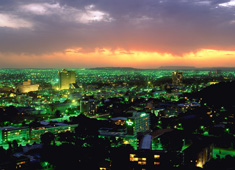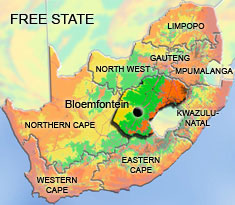Opportunities
Investing in the Free State
- Read more: Free State province, South Africa
Mining
Mining and agriculture were for many decades the bedrock of the Free State economy. The north-western part of the province sits on top of a rich gold-bearing reef more than 400km long, known as the goldfields region. South Africa is the world's largest gold producer, and the country's largest gold-mining complex is Free State Consolidated Goldfields, with an area of 330km⊃2.Agriculture
Large percentages of South Africa’s agricultural production, particularly grains, originate in the Free State. More than half the nation’s sorghum, nearly half the sunflower and more than 30% of all wheat, maize, potatoes and groundnuts come from the fertile plains of the western and northern Free State while the valleys of the east produce almost all of South Africa’s cherries and asparagus. Livestock and flowers are other important agricultural products.Need for Manufacturing
Critical to re-engineering the Free State economy is the necessity of building manufacturing capacity. As Premier Ace Magashule put it in his 2012 State of the Province address, "Undoubtedly we require a comprehensive industrial development strategy for the Free State." The premier was talking in the context of provincial growth rates of between 2% and 3% for 2010 and 2011. In his 2013 State of the Province address, however, Magashule noted that the Free State’s contribution to the national economy declined by about 11% between 1996 and 2010, and is projected to decline by another 4% between 2010 and 2015. With the primary sector (notably mining) declining in importance in the province from 50% of economic output to 13%, employment numbers have dropped. Finance MEC Seiso Mohai addressed this problem directly in the Provincial Budget Speech in March 2013: "We must transform and develop the main industries in our province, namely, mining, agriculture, manufacturing, tourism and infrastructure (both physical infrastructure and ICT). We must create and sustain the value-adding production sectors in mining and agriculture through beneficiation and agri-processing. We must also expand the manufacturing sector beyond the dominance of petrochemicals to include textiles and food processing as large portions of the manufacturing sector."Opportunities for growth
The current state and shape of Free State’s economy clearly presents huge opportunities for investors in the manufacturing sector. The Free State Development Corporation (FDC) is actively searching for investors, and giving them a helping hand, as in the construction of factories in the Harrismith and Botshabelo areas.- Free State Development Corporation: www.fdc.co.za
Planning
Economic planning for the province is attempting to integrate industrial development, rural development and the creation of sustainable small-, medium- and micro- enterprises. New economic drivers being targeted include logistics, ICT, innovation and research, agri-processing and manufacturing in sectors such as pharmaceuticals. The Sasolburg complex in the province's northern section is a highly industrialised and efficient focus of high-level production. As the headquarters of Sasol, and the site of the company's wax and chemical plants, the town is a major contributor to South Africa’s manufacturing sector. Several other chemical companies operate in the town. ChemCity is a business incubator downstream project promoting the sustainable use of byproducts from Sasol’s many plants. Sasol has recently made a series of investments to increase its capacity, with the wax production project representing the single biggest investment in any one project in the province's history. In 2012, Omnia opened its new nitric acid plant, a development that cost R1.4-billion.- Sasol: www.sasol.com
- ChemCity: www.chemcity.co.za
Geography
The landscape is characterised by wide open spaces in the west and beautiful valleys in the foothills of the Maluti mountains in the east. The province is sparsely populated, with a population of less than three million people mostly living in the north and east of the province. Sotho is the most widely spoken language, followed by Afrikaans. The region receives its rainfall in summer but sometimes the west and south can experience drought. The province is relatively well watered, with the Vaal and Orange rivers defining its northern and southern boundaries. In addition, a network of smaller rivers run through the area and run-off from hills and mountains ensure that the good soils of the area are well irrigated. The Gariep and Vaal dams are major sources of water and venues for recreation, as are the Free State’s lesser dams such as Sterkfontein, Allemanskraal and Kalkfontein. Tourism and aquaculture are just two potential income generators related to these water bodies.District municipalities
Mangaung Metropolitan MunicipalityTowns: Bloemfontein, Botshabelo and Thaba Nchu Bloemfontein is the main economic driver of the province, contributing about 25% of the gross regional domestic product. The Supreme Court of Appeal is located in Bloemfontein, which also has excellent schools and hosts the Central University of Technology, the University of the Free State and the Mangaung Nursing College of the Free State. Botshabelo is about 65km from Bloemfontein and has 140 factories located in it, many of them making textiles and clothing. Thaba Nchu lies still further to the east of the provincial capital and is popular with tourists. The infrastructure of the Mangaung Metropolitan Municipality is well developed and would be able to absorb much more development.
- Mangaung Metropolitan Municipality: www.bloemfontein.co.za
Towns: Ladybrand, Wepener The final stop-off point in South Africa for any traveller going to Lesotho is the busy town of Ladybrand in the Mantsopa Local Municipality. Tweespruit is a major sunflower seed production centre. In the Naledi Local Municipality, tourists are catered for on the Highlands of the Maluti Route. The steel bridge over the Caledon River at Wepener is a national monument. Xhariep District Municipality
Towns: Trompsberg, Koffiefontein, Zastron, Philipollis, Edenburg, Fauresmith, Smithfield The southernmost region of the Free State is a largely dry area with open grasslands predominating, although it is also home to the Gariep Dam, South Africa’s largest. Crops are produced in the northern parts of the district whereas sheep farming predominates in the south. Trompsberg has the second-biggest sheep-shearing barn in the country. Diamonds, gravel and clay are mined at Koffiefontein. Jagersfontein is one of the first places where diamonds were found, and it has its own version of the Big Hole to prove it. The town of Bethulie is a good stopping-over place for tourists wanting to experience the water sports available on the Gariep Dam. The dam is also the site of aquaculture projects which are intended to create employment and tackle food security. The nearby Tussen die Riviere Nature Reserve and the Mynhardt Game Reserve have a variety of wildlife in spectacular settings. Jacobsdal's Landzicht winery has proved itself as a worthy producer of wine. San rock paintings and Anglo-Boer War sites are plentiful. Fauresmith hosts an annual horse endurance race and Smithfield is the venue for a 'Chill' festival every winter, the 'Bibber Fees'. Lejweleputswa District Municipality
Towns: Welkom, Virginia, Boshof, Christiana, Bultfontein, Bothaville Mining is the most important economic activity in this area, also known as the Free State Goldfields, but it is also the most important maize-growing area in South Africa. Bothaville is the self-proclaimed Mielie Capital of South Africa but it is a name that is well-earned. It hosts an annual maize industry festival and conferences, and it is where Grain SA has its headquarters. Mining town Welkom is the major urban centre in the district. The town of Virginia is the site of a jewellery school and it is intended that this will form the nucleus of a jewellery beneficiation hub and an IT hub. The area has tourist assets such as a holiday resort on the Allemanskraal Dam, the Goldfields Wine Cellar in Theunissen and the Willem Pretorious Game Reserve, but there is potential for growth in the heritage sector. Fezile Dabi District Municipality
Towns: Sasolburg, Parys, Kroonstad, Frankfort, Heilbron, Viljoenskroon The chemical complex at Sasolburg is the economic driver in the district, which shares a border with Gauteng Province along the Vaal River. The town of Heilbron is another important industrial centre and Frankfort does important agri-processing work. Kroonstad is the subject of a separate article. A new kraft paper factory has been opened in Frankfort. A good proportion of South Africa’s grain crop is sourced from this district and when the vast fields of sunflowers and cosmos flowers are in bloom, a marvellous vista is created. The Vaal River presents opportunities for yachting, rafting and resort-based enterprises. Parys is a charming town and Vredefort is home to a World Heritage site – the Vredefort Dome where a meteor crashed to earth. Thabo Mofutsanyana District Municipality
Towns: Phuthaditjhaba, Bethlehem, Clarens, Harrismith, Vrede, Ficksburg Tourism and fruit farming are the two principal economic activities of this area which is characterised by beautiful landscapes: the Maluti and the Drakensberg mountain ranges, wetlands in the north, well-watered river valleys and the plains of the north and west. The most famous asset is the Golden Gate National Park. Industrial activity is undertaken at Harrismith and Phuthaditjhaba, where the Free State Development Corporation is promoting investment. Harrismith is the focus of efforts to create a multimodal transport and logistics hub. The commercial centre of the district is Bethlehem while Clarens and Ficksburg have become famous for their artists and cherries respectively. Ficksburg has two asparagus factories and, with nearby Marquard, produces 90% of South Africa’s cherries. The north of the district has many sunflower-seed farms. The Basuto cultural village in QwaQwa offers beautifully made crafts, and rock paintings can be seen as illustrations of the artistic skills of much earlier inhabitants of the area. This is an edited version of an article published by Frontier Market Network. Republished here with kind permission. Copyright © Frontier Market Intelligence Ltd. All rights reserved Reviewed: September 2013
 Bloemfontein, the capital of the Free State, at night (Image: South African Tourism)
Bloemfontein, the capital of the Free State, at night (Image: South African Tourism)
 The Free State takes up 10.6% of South Africa's total land area (Image: Mary Alexander)
The Free State takes up 10.6% of South Africa's total land area (Image: Mary Alexander)
 Map: Department of Environment and Tourism
Map: Department of Environment and Tourism
Related links
Free State: fast facts
Capital: Bloemfontein
Languages: 64.2% Sesotho, 12.7% Afrikaans, 7.5% isiXhosa
Population: 2 745 590 (2011)
Share of total SA population: 5.3%
Area: 129 825km2
Share of total SA area: 10.6%
Population density: 21 people per km2
Gross regional product: R145.4-billion (2010)
Share of total SA GDP: 5.5%
Languages: 64.2% Sesotho, 12.7% Afrikaans, 7.5% isiXhosa
Population: 2 745 590 (2011)
Share of total SA population: 5.3%
Area: 129 825km2
Share of total SA area: 10.6%
Population density: 21 people per km2
Gross regional product: R145.4-billion (2010)
Share of total SA GDP: 5.5%
Provincial investment guide
South Africa's provinces
Cities gallery
Johannesburg is the City of Gold, Cape Town the Mother City and Bloemfontein the Flower of the Free State. Take a photo tour of SA's world-class African cities.
SA industry gallery
SA is the powerhouse of Africa, with the most advanced, broad-based industrial sector on the continent.
Infrastructure photo gallery
Transport, energy, telecommunications: South Africa has the infrastructure of a fully developed country.
SA's countryside gallery
Step out of the urban centres and you'll find a different South Africa, an unexplored place of beautiful contrasts.







